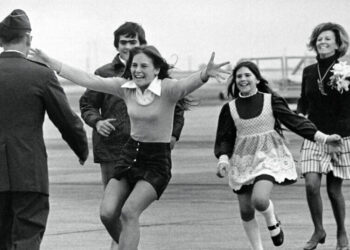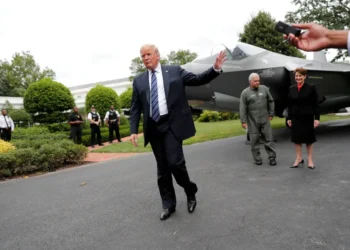Henry Todd, a Scotsman who helped run a drug ring that made and sold millions of LSD tablets in the 1970s, and who later turned to a different type of high, organizing mountain-climbing expeditions to the Himalayas, died on Nov. 3 in Kathmandu, Nepal. He was 80.
His family announced his death, in a hospital, but did not provide a cause.
LSD helped define the 1960s counterculture, spurred on by Timothy Leary, who preached the mantra “turn on, tune in, drop out.” The profits that were possible from manufacturing and distributing the psychedelic drug brought Mr. Todd into the business in 1970.
Backed by a financier in London, he worked with a chemist, Richard Kemp, to produce a very pure form of LSD. A brash personality, Mr. Todd became something akin to the endeavor’s marketing manager.
After a falling out with Mr. Kemp in 1973, Mr. Todd started a new LSD business in his house in Hampton Wick, near London. The lab was in the attic, and the tablets were made a floor below. Mr. Kemp established his own factory in Wales.
When police began piecing together evidence of the huge operation — which was making an estimated 90 percent of the LSD in Britain and supplying much of the world — they set up a task force, called Operation Julie, and began surveilling suspects.
The police came to characterize Mr. Todd as “energetic, secretive, a fast driver, intelligent, a good organizer but with a suspected violent temper,” Lyn Ebenezer wrote in a 2010 book, “Operation Julie: The World’s Greatest LSD Bust.” “He was outgoing, interested in mountaineering and traveling, loved good food and attractive women.”
“His motive was solely money,” Mr. Ebenezer added, which Mr. Todd spent on expensive dinners at the Savoy Grill in London, vacations in the Bahamas and rare stamps.
In March 1977, police raided dozens of houses in England, Wales and France related to the investigation. Handcuffed, Mr. Todd is said to have cheekily asked if the officers were there to give him the Queen’s Award for Industry.
Inside his home, police found cereal cartons filled with 20,000 British pounds (about £159,000 today, or $208,000) and enough LSD to make 2.5 million microdots, or little tablets. Three officers who pulled up the carpet, which was soaked with liquid LSD, were sent to the hospital after inadvertently getting high off the drug.
Five hundred thousand British pounds — about £4 million today, or $5.2 million — were reportedly found in Mr. Todd’s Swiss bank account.
He pleaded guilty to conspiring to possess LSD and aiding and abetting its possession by others, and was sentenced to 13 years in prison, as was Mr. Kemp. Mr. Todd served seven years, before re-emerging in a legitimate business on the other side of the world.
Henry Barclay Todd was born on March 3, 1945, in Broughty Ferry, Scotland, near Dundee. His father, Henry, was an officer in the Royal Air Force who served in Singapore, where young Henry spent part of his childhood. His mother, May, was in the Women’s R.A.F.
After attending a technical college but not graduating, Mr. Todd was a hospital porter and a photographer; spent two years in jail for theft and fraud; then worked as an accountant while also posing as a nude model at an art school in his spare time.
Mr. Todd, who stood 6-foot-3, grew interested in rock climbing and mountaineering and ventured to Switzerland when he was still in the LSD trade. A few years after his release from prison, he attempted to summit Annapurna in Nepal and, in time, reached the summits of other Himalayan peaks, like Mulkila, Ama Dablam, Pumori and Manaslu, according to the Summiters Club.
In 1989, he joined Polish climbers going to Everest.
“It was a very difficult expedition,” he told Outside magazine in a 2001 profile, “not terribly well run, and afterwards, I decided I wasn’t going to to go on any more expeditions if I wasn’t the leader. I felt they needed to be properly managed.”
He started Himalayan Guides and led his first trip to Everest in 1995, with eight climbers reaching the summit on a North Ridge ascent. He became a major expedition leader, notably on Everest climbs; he became known as the Mayor of Base Camp as well as the Toddfather and Seven-Year Todd (for his prison time). In all, he organized some 70 Himalayan expeditions, the Summiters Club reported.
Information on survivors was not immediately available.
Mr. Todd introduced climbing innovations, including a method of refilling oxygen bottles that decreased litter and a new way of fixing ropes to the mountain. He was also involved in two very public controversies.
Nepal banned him from the country for a year after he attacked Finn-Olaf Jones, a journalist for the Discovery Channel’s website, over some of Mr. Jones’s dispatches during an Everest climb in 2000. In one particularly provocative post, Mr. Jones had called Mr. Todd “a caterer” who “has not even been to the summit of Everest.”
Mr. Todd told Outside that he had shoved Mr. Jones, who stumbled and fell against a wall. Mr. Jones, who was airlifted from base camp, told The Independent: “It wasn’t your typical mountaineering injury that ended my Everest dream. It was a fist.”
In 2003, Mr. Todd, another tour operator and a guide were charged with manslaughter in the death of Michael Matthews — who in 1999, when he was 22, became the youngest British climber up to that time to reach the summit of Everest. Mr. Matthews vanished soon after in a blizzard, and his body was never found.
Mr. Matthews’s father pursued the criminal case, claiming that his son’s training was inadequate, that the oxygen cylinders Mr. Todd provided were faulty and that Michael Matthews had been left without guidance on his descent.
In dismissing the case in 2006, a judge wrote that “there was not one scrap of worthwhile evidence” to show that Mr. Todd’s oxygen cylinders had failed.
Mr. Todd was known for being temperamental. “He’s an awesome guy, and he’s a horrible guy, depending on who he wants to be,” Patrick Kenny, a Utah ski patroller, told Outside.
But Rolfe Oostra, an Australian mountaineer and expedition leader, recalled his bravery in a Facebook post in April.
“We all knew about his seven years in the slammer and how he forged his reputation as a badass mountaineer afterwards,” Mr. Oostra wrote, recalling an expedition to Everest in 2015 in which an earthquake struck the mountain and a large rock from an avalanche shattered Mr. Todd’s arm.
Mr. Todd “grabbed a shovel and dug and dug and dug for our crew that was buried deep below the rubble,” Mr. Oostra added. “He dug for days and days, and by the end flew out on the last helicopter home, stretched across the bodies of three of his Sherpa.”
Richard Sandomir, an obituaries reporter, has been writing for The Times for more than three decades.
The post Henry Todd, LSD Kingpin Turned Everest Guide, Dies at 80 appeared first on New York Times.




